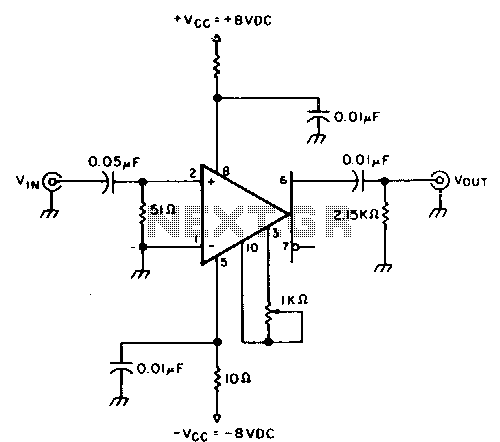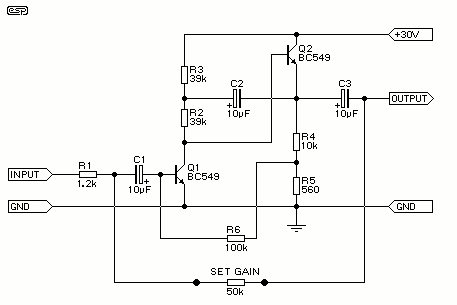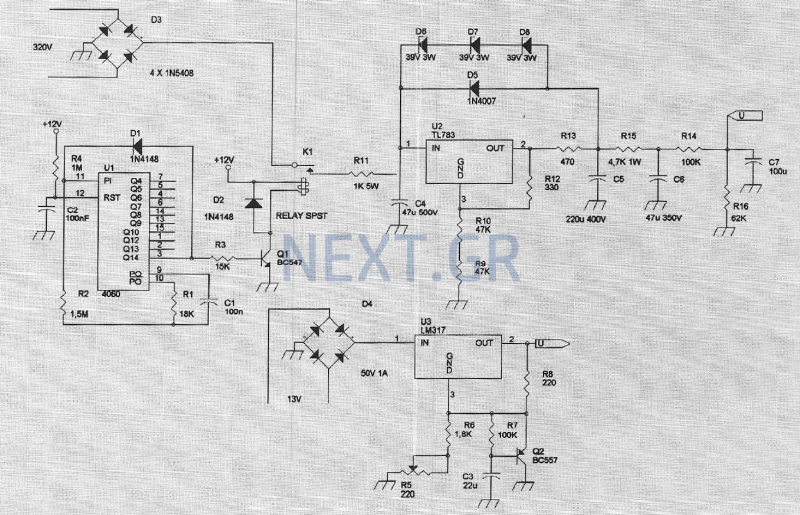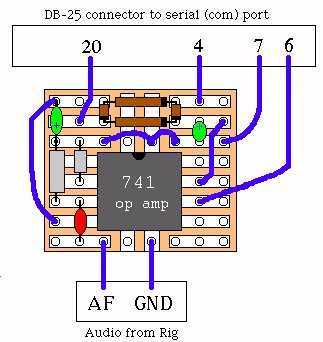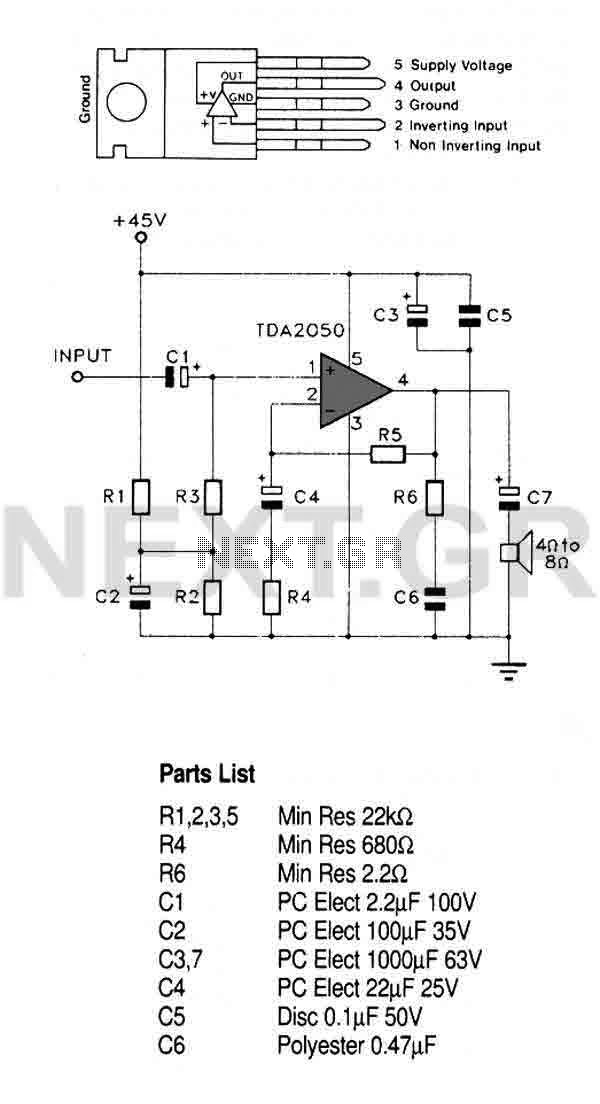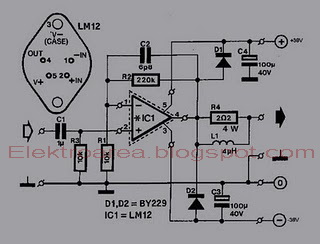
Crystal Radio RF Amplifier
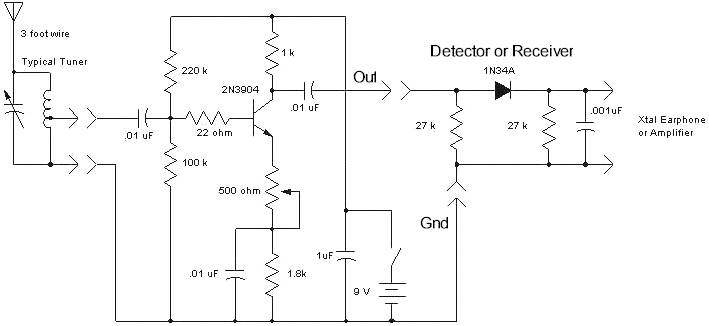
The circuit presented is a straightforward yet efficient amplifier that can provide notable performance enhancements. This amplifier can demonstrate negative resistance at lower settings of the 500-ohm potentiometer, resulting in increased gain or even oscillation. Consequently, the circuit can be regarded as a regenerative receiver with an external detector. Its sensitivity is sufficiently high that it does not require a cold water pipe ground, and it can operate effectively with a short antenna. The amplifier's performance is influenced by its connection to the tuned circuit. When connected to a lower impedance tap as illustrated in the schematic, the gain is reduced, leading to a diminished tendency to oscillate. Conversely, connections to higher taps or directly to the antenna yield greater gain and potential oscillation. The 500-ohm potentiometer is fine-tuned to provide suitable gain without producing unwanted feedback as stations are adjusted. High regeneration settings can narrow the bandwidth of the tank circuit, imparting a "mellow" sound quality, which is particularly appealing when using a "tinny" crystal earphone. Lower settings are preferable when interfacing with an audio amplifier, as the fidelity remains quite good due to the linear detector employed (as opposed to typical regenerative circuits that rely on variations in the transistor's operating point for RF demodulation). As with any regenerative circuit, gain can be increased after the desired station is tuned in, causing the circuit to oscillate, synchronized to the station's frequency. Longer antennas should be connected to taps rather than across the entire coil. A ferrite loopstick can effectively pick up stronger signals without any antenna, but it necessitates increased audio gain following the diode detector and a reduction in regeneration to maintain adequate bandwidth; otherwise, the sound quality may become muffled.
The circuit functions primarily as a regenerative amplifier, leveraging the unique characteristics of a transistor to achieve amplification and oscillation. The 500-ohm potentiometer plays a crucial role in adjusting the gain and controlling feedback, which is essential for maintaining stability while tuning into different stations. The connection points to the tuned circuit are critical; lower impedance taps provide a stable operating condition with reduced gain, while higher taps allow for greater amplification and potential oscillation, enhancing the circuit's ability to pick up weak signals.
The amplifier's design also incorporates a linear detector, which demodulates the radio frequency (RF) signals with improved fidelity compared to traditional regenerative circuits. This feature is particularly advantageous when the circuit is used in conjunction with audio amplifiers, as it ensures that the output sound quality remains clear and precise. The ability to adjust the regeneration level not only affects the gain but also influences the bandwidth of the received signals, allowing for a tailored listening experience based on the user's preferences.
In practical applications, the circuit can be enhanced by using longer antennas connected to taps, thereby improving reception quality. The use of a ferrite loopstick is recommended for environments with strong signals, as it can function effectively without an external antenna. However, careful adjustments to audio gain and regeneration settings are necessary to avoid distortion and ensure a balanced output. Overall, this amplifier circuit offers a versatile solution for radio enthusiasts seeking to improve their listening experience through effective gain control and signal processing techniques.The circuit below is a simple but effective amplifier which will give surprising performance improvement. This amplifier can exhibit negative resistance for low settings of the 500 ohm pot which results in extra gain or even oscillation.
So, the circuit can actually be considered to be a regenerative receiver with an external detector. The sensitivity is so high that no cold water pipe ground is needed and the antenna is short. The behavior of the amplifier depends on how it is connected to the tuned circuit. When connected to a lower impedance tap as shown in the schematic, the gain will be lower with less tendency to oscillate. Higher taps or even connection directly to the antenna will give higher gain and even oscillation. The 500 ohm pot is adjusted to give adequate gain without squealing as stations are tuned. High regeneration settings will actually narrow the bandwidth of the tank enough to give the sound a "mellow" quality which sounds pretty good in a "tinny" crystal earphone!
Lower settings are best when using an audio amplifier and the fidelity is quite good thanks to the linear detector (typical regens use changes in the operating point of the transistor to demodulate the RF). As with any regen, the gain may be increased after the station is tuned in and the circuit will oscillate, locked to the station`s frequency.
Longer antennas should be connected to taps instead of across the whole coil. A ferrite loopstick will pick up stronger stations with no antenna at all but use more audio gain after the diode detector and reduce the regeneration to get adequate bandwidth or the sound will be muffled. Be the first of your friends to get free diy electronics projects, circuits diagrams, hacks, mods, gadgets & gizmo automatically each time we publish.
Your email address & privacy are safe with us ! 🔗 External reference
The circuit functions primarily as a regenerative amplifier, leveraging the unique characteristics of a transistor to achieve amplification and oscillation. The 500-ohm potentiometer plays a crucial role in adjusting the gain and controlling feedback, which is essential for maintaining stability while tuning into different stations. The connection points to the tuned circuit are critical; lower impedance taps provide a stable operating condition with reduced gain, while higher taps allow for greater amplification and potential oscillation, enhancing the circuit's ability to pick up weak signals.
The amplifier's design also incorporates a linear detector, which demodulates the radio frequency (RF) signals with improved fidelity compared to traditional regenerative circuits. This feature is particularly advantageous when the circuit is used in conjunction with audio amplifiers, as it ensures that the output sound quality remains clear and precise. The ability to adjust the regeneration level not only affects the gain but also influences the bandwidth of the received signals, allowing for a tailored listening experience based on the user's preferences.
In practical applications, the circuit can be enhanced by using longer antennas connected to taps, thereby improving reception quality. The use of a ferrite loopstick is recommended for environments with strong signals, as it can function effectively without an external antenna. However, careful adjustments to audio gain and regeneration settings are necessary to avoid distortion and ensure a balanced output. Overall, this amplifier circuit offers a versatile solution for radio enthusiasts seeking to improve their listening experience through effective gain control and signal processing techniques.The circuit below is a simple but effective amplifier which will give surprising performance improvement. This amplifier can exhibit negative resistance for low settings of the 500 ohm pot which results in extra gain or even oscillation.
So, the circuit can actually be considered to be a regenerative receiver with an external detector. The sensitivity is so high that no cold water pipe ground is needed and the antenna is short. The behavior of the amplifier depends on how it is connected to the tuned circuit. When connected to a lower impedance tap as shown in the schematic, the gain will be lower with less tendency to oscillate. Higher taps or even connection directly to the antenna will give higher gain and even oscillation. The 500 ohm pot is adjusted to give adequate gain without squealing as stations are tuned. High regeneration settings will actually narrow the bandwidth of the tank enough to give the sound a "mellow" quality which sounds pretty good in a "tinny" crystal earphone!
Lower settings are best when using an audio amplifier and the fidelity is quite good thanks to the linear detector (typical regens use changes in the operating point of the transistor to demodulate the RF). As with any regen, the gain may be increased after the station is tuned in and the circuit will oscillate, locked to the station`s frequency.
Longer antennas should be connected to taps instead of across the whole coil. A ferrite loopstick will pick up stronger stations with no antenna at all but use more audio gain after the diode detector and reduce the regeneration to get adequate bandwidth or the sound will be muffled. Be the first of your friends to get free diy electronics projects, circuits diagrams, hacks, mods, gadgets & gizmo automatically each time we publish.
Your email address & privacy are safe with us ! 🔗 External reference
